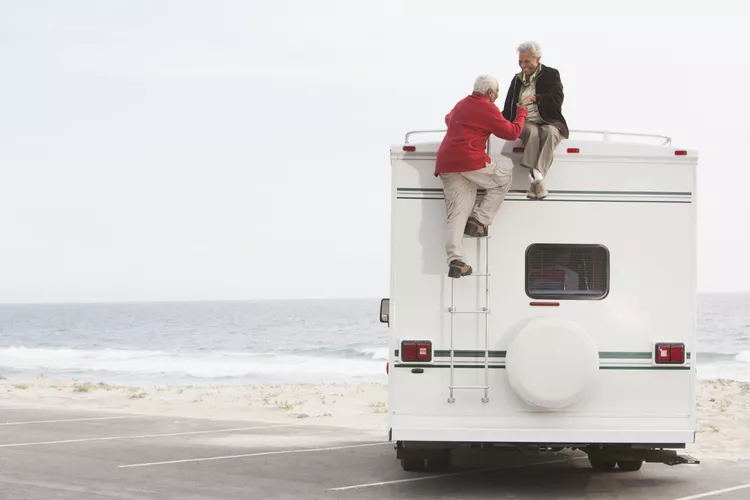Essential Propane Safety Tips for RVers
Most RVers use propane for heat, refrigeration, hot water, or cooking. Since regulations change over time, you can get the most current information on propane regulation at the National Fire Protection Association (NFPA) site. Veteran RVers generally develop a routine for checking the safety of their propane systems. Each task on your RV checklist is crucial and worth taking care of thoroughly, especially with respect to your RV propane tank.
RV tank sizes vary, but 20 lb. and 30 lb. tanks are among the common sizes. These tanks are sometimes described in terms of the volume they hold in gallons. For example, the 20 lb. tank is sometimes referred to as a 5-gallon tank; however, this isn’t the most accurate way of describing size. A 20 lb. tank actually holds closer to 4.7 gallons. It’s more precise to refer to tank sizes by the number of pounds of propane they hold rather than gallons. Propane tanks are filled to 80 percent capacity, leaving a safety cushion of 20 percent for gaseous expansion.
RVers need to be aware of several propane tank features because these features affect the safety of your propane system and management of the system:
- Characteristics of propane
- Propane tank and system safety and inspections
- Pressure gauge
- Overfill protection device (OPD)
- Connectors
- Tank color
Characteristics of Propane
Propane is maintained under pressure inside the tank in a liquid state at -44 degrees F, its boiling point. At temperatures warmer than -44 degrees, propane vaporizes into a gaseous state that is suitable for burning.
If you see a white fog leaking from your propane tank or any connection point, this indicates a leak, as this is the visual appearance of low-temperature propane vapor. Because it is so cold, it can easily cause frostbite. Therefore, don’t attempt to repair the leak yourself; instead, call a propane dealer immediately, avoid using anything electrical or that can cause a spark, and maintain a safe distance from the leak.
Propane Tank and System Safety and Inspections
Your tanks need to be strong enough to contain the pressure required to maintain propane in a liquid state. Dents, rust, scrapes, gouges, and weakened valve connectors can be significant points for propane leaks under pressure.
Consequently, it is essential to have your tanks inspected periodically by a Railroad Commission-licensed propane gas supplier. Some RVers have their tanks inspected by the supplier where they have their tanks filled, while some RV dealers are also qualified to perform both tank inspections and inspect your RV’s entire propane system. Annual inspections are wise for RV propane systems, but tanks should be certified at least every five years.
Pressure Gauge
Your pressure gauge indicates how full your tank is in fractions: 1/4, 1/2, or 3/4 full. However, because temperature variations affect pressure as the tank volume changes, these readings can be slightly inaccurate. Inaccuracy increases as the volume decreases. You will develop a sense of how long your propane will last after using a few tanks, depending on whether you use your propane for heating your water only or also to power your refrigerator, heater, and stove.
Overfill Protection Device (OPD)
The OPD is required on all propane tanks up to 40-pound capacity on tanks manufactured after September 1998. There is conflicting information indicating that tanks manufactured prior to that date, particularly ASME horizontal tanks, were grandfathered in per the NFPA regulations. However, an article by Foremost Insurance states that old cylinders can no longer be refilled without installing an OPD, and some suppliers might refuse to fill these tanks. Check the NFPA site for current regulations.
Connectors
Numerous connections and fittings attach to your propane tank and propane system within your RV. These should be checked periodically. Annual inspections are recommended, especially for your RV system. Some tank inspections are valid for five years.
Tank Color
Propane tank color may seem to be just a cosmetic concern; nonetheless, it is important. Light colors reflect heat, while dark ones absorb heat. You want your tanks to reflect heat, so avoid the temptation to paint them a dark color, even if it would match your rig perfectly.
State Regulations
As you travel around the country, your propane refills may be handled differently. Different states might have varying regulations, in addition to federal regulations concerning propane tanks. For instance, Texas requires its propane suppliers to use three measures for determining a full tank, including weighing on a scale, using the OPD, and the fixed liquid level gauge.
Propane Leak Detector
Every RV should be equipped with a working propane leak detector placed inside. Propane gas can leak from stoves, heaters, refrigerators, or water heaters. It can escape from any connector on the propane system and from any break in the lines feeding these appliances. If you smell propane, or if your propane leak detector alarms, evacuate the RV immediately. Do not turn on or off any electrical devices, and avoid sparks. Once you are at a safe distance from your RV, contact a propane service professional, and if necessary, alert nearby neighbors whose RVs may be at risk should a fire break out.
Traveling with Propane
Driving with propane turned off may seem like common sense; however, forgetting to turn your propane tanks off before traveling is a mistake that is easy to make. It is illegal to have your vehicle in motion with your propane tank valves open, posing significant risks when traveling through tunnels. It does not take much imagination to realize the dangers of escaping a burning RV in a tunnel, on a bridge, or on the highway. Therefore, play it safe and prevent fires.





